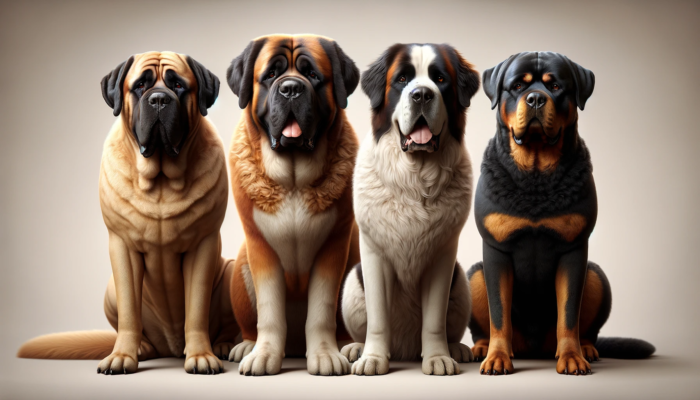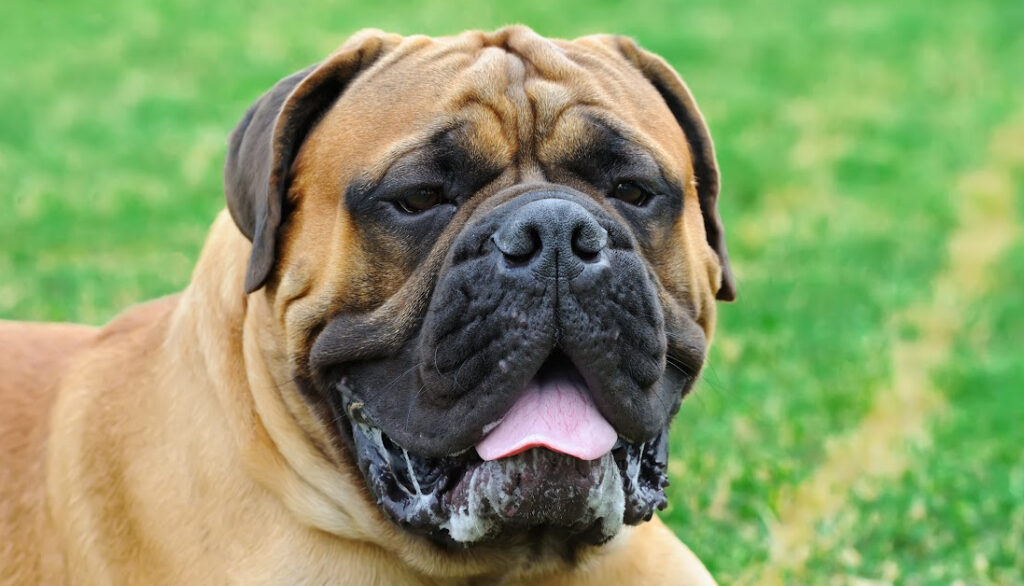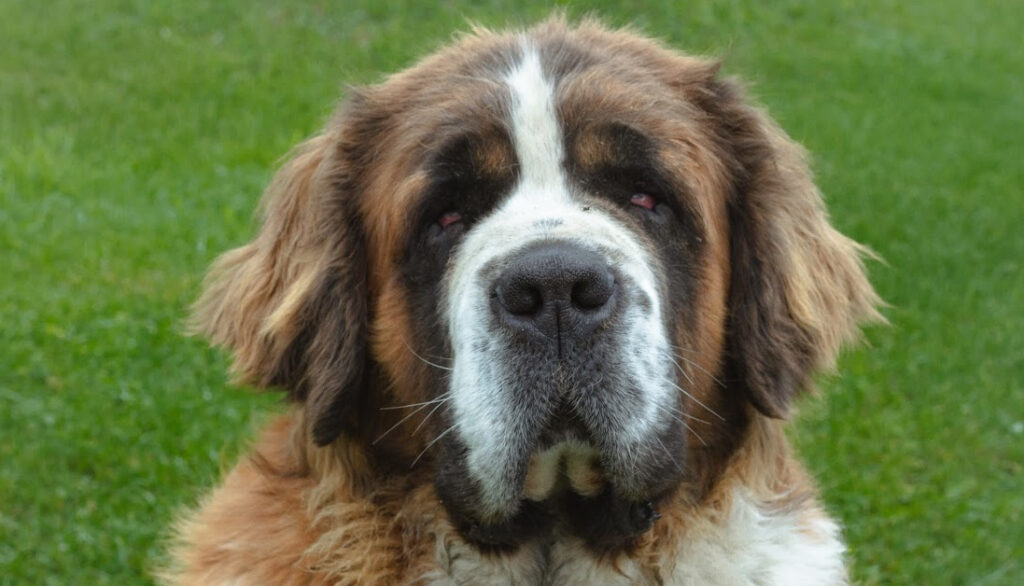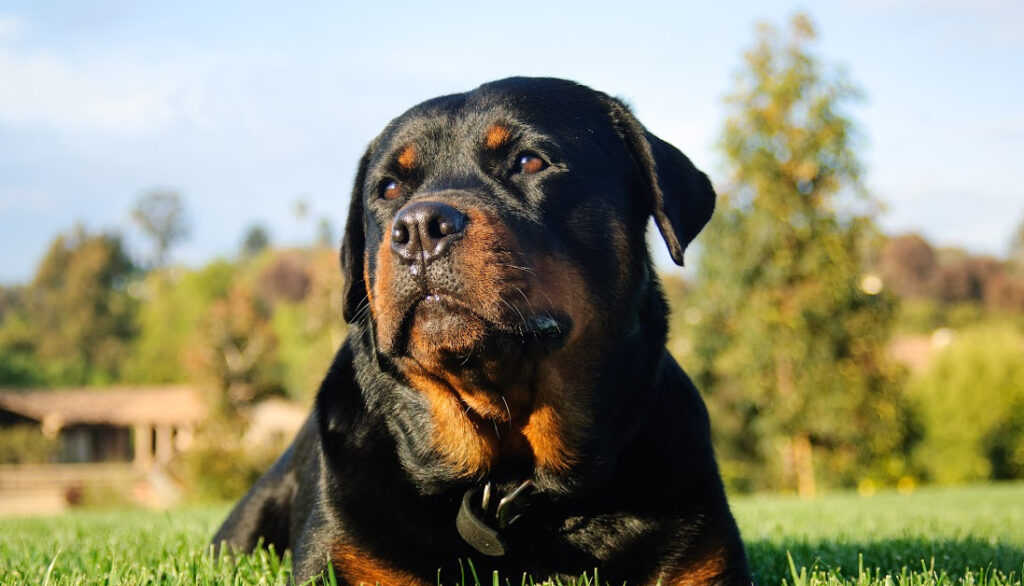Have you ever found yourself mesmerized by a dog’s big, adorable head? Some of us can’t resist these gentle giants. In this article, we’re going to delve into the world of dog breeds with big heads. We’ll explore what makes these breeds so endearing and discover their unique characteristics.

The appeal of large-headed dogs is undeniable. With their broad skulls and expressive eyes, these dogs have an inherent charm that can make any dog lover’s heart melt. But it’s not just their size that makes them special. Dogs with big heads often have strong jawlines, giving them a distinctive, dignified appearance. They also tend to be quite intelligent and have a calm demeanor, which can make them excellent companions.
However, the size of a dog’s head isn’t just a fascinating aesthetic feature; it’s also an interesting area of scientific study. A dog’s head size and shape are influenced by genetic factors. For instance, breeds like the Mastiff and the Great Dane have been selectively bred over generations to have large heads. However, it’s important to note that big-headed breeds can be prone to certain health issues, such as hip dysplasia and certain neurological conditions.
While the allure of big-headed dogs is hard to resist, it’s crucial to know that they also come with specific care requirements. From their nutritional needs to exercise and training considerations, these breeds need a committed and knowledgeable owner.
So, if you’re considering adopting a large-headed dog breed, stay tuned as we delve deeper into the unique world of these beautiful canines, exploring everything from their pop culture presence to the important considerations before adopting one.

The Science Behind Big Heads in Dogs
Ever wondered why some breeds of dogs have significantly larger heads than others? Well, buckle up! We’re about to embark on an exciting journey into the world of genetics and health, diving into the captivating science behind big-headed dogs.
Genetic Factors Influencing Head Size
The size and shape of a dog’s head are largely determined by its genetic makeup. Just like how you and I get our hair color and height from our parents, so do our four-legged friends inherit their cranial dimensions. The genes responsible for big heads in dogs are dominant, meaning that if a puppy has even one parent with a large head, the chances are high that it will also grow to have one. This trait is often associated with certain breeds like English Mastiffs, American Staffordshire Terriers, and Boxers, all known for their distinctively large noggins.
Furthermore, the role of selective breeding can’t be ignored. Humans have been selectively breeding dogs for thousands of years, choosing to mate dogs with desirable traits to produce offspring with those same characteristics. Breeds with larger heads were often favored for their perceived strength and guarding abilities, leading to the prevalence of big-headed breeds we see today. Isn’t it fascinating how much human decisions have shaped our canine companions?
Health Implications of Larger Cranial Features
While those big heads are undeniably adorable, it’s essential to understand the health implications that can come along with them. A larger head can lead to a more difficult birthing process for the mother dog, often necessitating C-sections. Furthermore, breeds with large heads are more prone to certain health conditions.
For instance, Brachycephalic breeds, such as Bulldogs and Pugs, are characterized by their broad, short skulls. This distinctive head shape can lead to Brachycephalic Syndrome, a condition that can cause breathing difficulties due to the compression of the upper airways.
On the other hand, large-headed breeds like the Bernese Mountain Dog and the Saint Bernard are susceptible to a condition called Wobbler Syndrome. This neurological disorder can cause instability and wobbling in the dog’s gait, often due to the size and weight of their large heads.
Remember, recognizing the potential health risks associated with your pup’s big head doesn’t mean you should love them any less. Instead, it helps you become a more informed and prepared pet parent. After all, knowledge is the first step to prevention and early intervention.
Indeed, the world of dog breeds with big heads is filled with intrigue and wonder. From the role of genetics to the implications on health, every aspect offers a profound insight into the unique world of our beloved pets. As we continue to explore and appreciate these beautiful creatures, let’s never forget that their health and wellbeing should always come first.
Iconic Large-Headed Dog Breeds
When we delve into the world of **dog breeds with big heads**, two breeds set the bar high, the majestic Mastiffs and the dignified Great Danes.
The Majestic Mastiffs
Mastiffs, also commonly referred to as English Mastiffs, are one of the most popular large-headed dog breeds. These gentle giants possess a substantial powerful build and a distinctly broad skull. Their heads are square in appearance and are highlighted by a short, wide muzzle and pronounced stop (the point where the muzzle meets the forehead).
A mature male Mastiff typically weighs between 160-230 pounds, while females weigh slightly less at 120-170 pounds. Despite their size, they are known for their calm and composed demeanor. They’re typically gentle with children, making them a great family pet.
Their coat is relatively easy to maintain, requiring only occasional brushing. However, due to their size, they might need a little more space than your average dog and they do have a tendency to drool!
The Dignified Great Danes
The Great Dane may not have a head as wide as a Mastiff, but it’s certainly one of the dog breeds with the largest heads in proportion to their body. This breed has a long and noble history dating back to ancient times, and their giant stature and resonant bark have made them iconic watch dogs.
Great Danes stand between 28-32 inches tall, making them one of the tallest dog breeds. Their heads are rectangular and elongated, marked by a deep muzzle and well-defined stop. Male Great Danes can weigh anywhere between 140-175 pounds, while females can weigh between 110-140 pounds.
Despite their imposing stature, Great Danes are renowned for their gentle and friendly nature. Dubbed as ‘gentle giants’, they are known for their affection towards their human companions and can be great with kids.
Their short coat requires minimal grooming, but their large size means they’ll need plenty of space at home and lots of exercise.
In conclusion, both Mastiffs and Great Danes are excellent examples of **dog breeds with big heads**. Whether you’re drawn to the broad and robust head of the Mastiff or the elongated and noble features of the Great Dane, these large-headed breeds each have unique characteristics that make them fantastic pets. If you are considering bringing one of these breeds into your home, make sure to prepare for their size and specific needs to ensure they live a healthy, happy life.
Dog Breeds with Big Heads: Meet the Large-Headed Pooches of the Canine World
Comprehensive List of Large-Headed Breeds
Broad, powerful, and distinguished – these words aptly describe our four-legged friends who boast larger than average craniums. Some of the most notable large-headed dog breeds include:
- Mastiffs: Ranging from the English Mastiff to the Neapolitan Mastiff and Bullmastiffs, these breeds are known for their massive heads.
- Great Danes: Despite their elegant stature, Great Danes have notably large skulls.
- Saint Bernards: These gentle giants are famous not only for their size but also for their large heads.
- Boxers: Boxers have a unique square-shaped head that’s easily recognizable.
- Rottweilers: Rottweilers feature an impressive head, fitting for such a powerful breed.
- Newfoundlands: Known for their sweet nature, these dogs also sport a sizable head.
Unique Traits of Each Breed
Every big-headed dog breed possesses its unique traits that set them apart.
Mastiffs are known for their protective nature, making them excellent guard dogs. Their big heads house a strong bite, essential for their protective duties.
The Great Dane, often referred to as the ‘Apollo of Dogs’, is a gentle giant despite its large size and head. They are friendly, patient, and dependable, making them great family pets.
Known for its iconic barrel and neck flask, the Saint Bernard is a symbol of rescue and assistance. These dogs are famed for their strength, intelligence, and unlimited love for their family.
A Boxer’s broad head is just one part of their overall muscular physique. They’re playful, energetic, and their protective instinct makes them great watchdogs.
The Rottweiler is a confident and courageous breed. Their large heads are a testament to their strength and they serve as great working or companion dogs.
Last but not least, the sweet-tempered Newfoundland is a fantastic swimmer. Their large heads are powerful, but their true strength lies in their compassionate hearts, making them perfect rescue dogs.
From the powerful bite of a Mastiff to the gentle demeanor of a Great Dane, large-headed dog breeds each bring something unique to the table. Whether you want a protective guard dog, a lively playmate, or a calm companion, you’re sure to find a dog breed with a big head that fits your lifestyle perfectly.

Caring for Dogs with Large Heads
Special Nutritional Needs
When it comes to caring for dog breeds with big heads, it’s essential to pay special attention to their diet. While these dogs may have the same nutritional needs as other breeds, their larger size often means they require more food.
- – Protein: This is a vital nutrient for all dogs, but especially for large breeds. It helps build and repair muscles and other tissues. Look for high-quality dog food that lists a source of animal protein as the first ingredient.
- – Fats: Fats provide energy and help keep your dog’s skin and coat healthy. However, too much fat can lead to obesity, which can be a concern for large breeds.
- – Carbohydrates: Carbs provide energy and fiber, which aids digestion. Choose dog food with complex carbs like sweet potatoes or brown rice.
- – Vitamins and Minerals: These are essential for overall health. They support everything from bone health to immune function.
Remember, every dog is unique, and what works for one might not work for another. Always consult with your vet to determine the best diet for your particular pet.
Exercise and Training Considerations
Exercise is crucial for all dogs, but it’s especially important for large breeds. Regular exercise helps maintain a healthy weight, which is essential for dogs with big heads as they’re often prone to joint issues due to their size.
However, it’s important to remember that not all exercises are suitable for large breeds. High-impact activities like jumping or frisbee catching can put too much stress on their joints. Instead, consider low-impact exercises like swimming or walking.
Training is also a key consideration. Large-headed breeds often have a strong protective instinct, which can be a double-edged sword. While it’s great for home security, it can also lead to aggressive behavior if not properly managed.
Start training your large-headed pup from a young age. Socialize them with other dogs and people to help them develop a calm and friendly demeanor.
Don’t forget mental stimulation, too. Many large-headed breeds are intelligent and require mental exercise to prevent boredom. Puzzle toys, obedience training, and interactive games can all help keep your dog’s mind sharp.
In summary, caring for dog breeds with big heads involves a careful balance of the right nutrition, appropriate exercise, and effective training. These dogs may require a bit more attention than smaller breeds, but the love and loyalty they offer in return are more than worth it.
Grooming and Maintenance for Big-Headed Breeds
Just like us, our pooches need a little pampering too. When it comes to dog breeds with big heads, grooming can be a unique challenge, but don’t worry, I’ve got you covered!
Grooming Tips for Large-Headed Dogs
One of the most overlooked areas during grooming is a dog’s head. Because it’s such a focal point, it needs extra attention. Here are some tips to ensure your big-headed dog stays looking fabulous:
- Regular Brushing: Depending on your dog’s coat type, you’ll need to brush it often to prevent matting and keep it shiny. Most large-headed breeds, like Mastiffs and Great Danes, have short coats that require minimal grooming. However, brushing is still important to remove loose hairs and stimulate the skin.
- Ear Care: Dogs with big heads often have large ears too – and they can be a breeding ground for bacteria if not cleaned properly. Make a habit of checking your dog’s ears once a week for any signs of infection, like redness, swelling, or a bad smell.
- Eyes Cleaning: Just like ears, a dog’s eyes can also be prone to infections. Clear away any discharge with a soft, damp cloth and keep a lookout for any abnormalities. Always consult your vet if you notice anything unusual.
- Dental Hygiene: Large breeds are prone to dental issues, so regular brushing is crucial. Use a dog-specific toothpaste and brush, and consider dental chews as an additional measure.
Health Maintenance and Regular Check-Ups
When it comes to dog breeds with big heads, regular health check-ups are essential. Due to their size, these breeds can be prone to specific health issues, such as hip dysplasia and heart problems.
It’s crucial that your big-headed pooch gets a thorough check-up at least once a year. While at the vet, keep an eye on:
- Weight: Obesity can lead to a range of health problems, so keep track of your dog’s weight and adjust its diet and exercise routine as needed.
- Vaccinations: Ensure your dog’s vaccinations are up-to-date to prevent serious illnesses.
- Heart Health: Large breeds can be more prone to heart problems, so ask your vet to pay special attention to this during check-ups.
Remember, regular grooming and health check-ups aren’t just about keeping your dog looking good – they’re vital aspects of ensuring your pet’s overall wellbeing. Because when it comes to our furry friends, a little care goes a long way!

The Popularity of Big-Headed Dogs in Culture
Big-headed dog breeds are not just loved for their unique and distinctive appearances, they also hold a significant place in our culture and media. Let’s delve into some of the ways these endearing breeds have captured our hearts and imaginations.
Large-Headed Dogs in Media and Entertainment
Consider some of the most memorable dogs in film and television – many are dog breeds with big heads. Hollywood’s fondness for these breeds is clear, and they’re often cast for their imposing stature and expressive faces.
- – Beethoven, the drooling St Bernard in the Beethoven movie series, is one of the most recognized large-headed breeds in the entertainment industry. This breed’s large, soulful eyes and massive head made it an instant hit on the big screen.
- – Another notable breed is the English Mastiff, which starred in the Harry Potter series as Fang, Hagrid’s loyal companion. Despite their intimidating appearance, Mastiffs are known for their gentle and calm nature.
- – The lovable and goofy Great Dane named Scooby-Doo is arguably one of the most famous animated dogs on television.
These examples show how big-headed dog breeds have played a crucial role in the media and entertainment industry, further increasing their appeal and popularity.
Symbolism and Representation in Society
Dog breeds with big heads often carry symbolic meanings in different societies, representing power, protection, and loyalty.
- – The Mastiff, for instance, has been widely known in history as a symbol of nobility and grandeur due to its large size and head. In many cultures, Mastiffs are seen as protectors and guardians.
- – Similarly, the Great Dane, often referred to as the “Apollo of dogs,” symbolizes strength and majesty. Their large heads and towering physique are seen as a representation of power and dominance.
- – Pit Bulls, a breed often misunderstood due to their muscular build and large head, are seen by many as symbols of resilience and loyalty. Despite the negative stereotypes, Pit Bull advocates highlight the breed’s courage, determination, and unwavering loyalty.
The symbolism and representation of large-headed dog breeds in society often speak to their character traits. While they may be seen as imposing or intimidating due to their large heads and powerful builds, these breeds are often characterized by their gentleness, loyalty, and loving nature.
In conclusion, large-headed dog breeds, from the playful St Bernard to the dignified Mastiff, carry a special place in our hearts and culture. Whether they’re stealing the show in our favorite movies, symbolizing strength and courage, or simply being our loyal companions, these breeds continue to captivate us with their unique charm and appeal. As a dog parent, understanding and appreciating these breeds’ cultural significance can deepen our bond with these furry friends.
Adopting a Large-Headed Dog Breed
So you’ve decided to adopt one of the many adorably distinguished dog breeds with big heads, and you’re likely filled with excitement and anticipation. However, before you rush out to bring home your new four-legged friend, let’s discuss a few essential considerations that can help ensure you’re making the best decision for both of you.
What to Consider Before Adoption
Firstly, picture the lifestyle you lead or the one you aim to lead with your dog. Some large-headed breeds like the Mastiffs or Great Danes require ample space, given their size. They wouldn’t be as comfortable in an apartment as they would be in a house with a yard. However, some dogs, like the Boxers, can adapt well to smaller spaces as long as they get plenty of exercises.
Next, consider the time you can dedicate to their care. Dogs with big heads often come with equally big bodies, and they need regular exercise to stay healthy and burn off energy. Not to mention, training can take significant time and patience, especially if you’re bringing home a puppy.
Also, remember that some big-headed breeds may have special dietary needs and grooming requirements. Dogs with deep skin folds, like Bulldogs, can require regular cleaning to avoid infections. Additionally, you’ll need to budget for potentially higher veterinary costs due to the health implications associated with larger cranial features.
Finding a Responsible Breeder or Rescue Organization
Once you’ve carefully considered these factors and concluded that a large-headed breed is indeed the right fit for you, the next step is to find a responsible breeder or rescue organization. Here are a few tips to guide you:
- Look for breeders who test their breeding dogs for genetic diseases common to that breed. They should be willing and able to show you the test results.
- Responsible breeders prioritize the welfare of their dogs over making a profit. Beware of breeders who always have puppies available or who seem more interested in your money than in ensuring a good home for their dogs.
- If you’re considering adopting from a rescue organization, research to ensure it’s reputable. They should provide medical care for their animals and be transparent about any known health issues or behavioral problems.
By doing thorough research and considering your lifestyle, you’re more likely to find a dog breed with a big head that fits well into your home and heart. Remember, adopting a dog is a commitment that lasts for the life of the pet, and each dog breed comes with its unique set of characteristics, needs, and rewards. So while our large-headed friends might be irresistible with their majestic looks and lovable personalities, they deserve owners who are fully prepared and committed to providing them with the best life possible.
Once you find that perfect pup, you’re on your way to experiencing the unmatched joy and companionship that dog ownership brings. Here’s to the start of a beautiful friendship with your new large-headed, big-hearted canine companion!
Frequently Asked Questions
Q1: What are some examples of dog breeds with big heads?
A: Some examples of dog breeds with big heads include the Bullmastiff, Saint Bernard, and the Newfoundland.
Q2: Does the size of a dog’s head affect its intelligence or behavior?
A: No, the size of a dog’s head does not directly correlate with its intelligence or behavior. These traits are more closely related to the breed’s genetics and upbringing.
Q3: Are there any specific health issues associated with large-headed dog breeds?
A: Some large-headed breeds may be prone to certain health issues, such as hip dysplasia or certain types of cancer. However, this varies greatly from breed to breed and individual to individual.
Q4: Are large-headed dog breeds more aggressive than other breeds?
A: The size of a dog’s head does not determine its temperament. Aggression in dogs is usually a result of poor socialization, lack of training, or genetic factors.
Q5: Do large-headed dog breeds require special care or considerations?
A: Large-headed breeds may require more food and space than smaller breeds. They may also be more prone to certain health issues, so regular vet check-ups are important. However, the specific care requirements will vary depending on the breed and individual dog.
Dr. Candy, a holistic veterinarian and certified raw dog food nutrition specialist, graduated from Oklahoma State University in 2009 with a DVM and has since specialized in companion animal nutrition, advocating for species-specific diets. With a background in wildlife rehabilitation and oil spill response, she combines holistic health and conventional medicine in her unique approach to treating chronic diseases, allergies, and autoimmune conditions in pets. As the owner of a veterinary practice in Colorado and an author, Dr. Candy is dedicated to educating pet parents and improving the health and happiness of animals.




